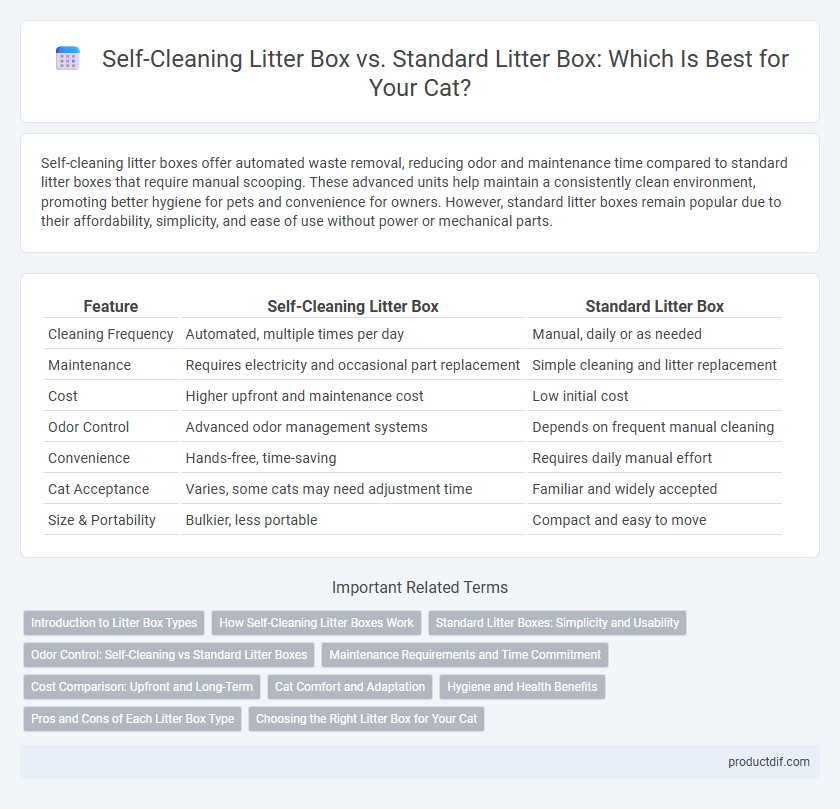Self-cleaning litter boxes offer automated waste removal, reducing odor and maintenance time compared to standard litter boxes that require manual scooping. These advanced units help maintain a consistently clean environment, promoting better hygiene for pets and convenience for owners. However, standard litter boxes remain popular due to their affordability, simplicity, and ease of use without power or mechanical parts.
Table of Comparison
| Feature | Self-Cleaning Litter Box | Standard Litter Box |
|---|---|---|
| Cleaning Frequency | Automated, multiple times per day | Manual, daily or as needed |
| Maintenance | Requires electricity and occasional part replacement | Simple cleaning and litter replacement |
| Cost | Higher upfront and maintenance cost | Low initial cost |
| Odor Control | Advanced odor management systems | Depends on frequent manual cleaning |
| Convenience | Hands-free, time-saving | Requires daily manual effort |
| Cat Acceptance | Varies, some cats may need adjustment time | Familiar and widely accepted |
| Size & Portability | Bulkier, less portable | Compact and easy to move |
Introduction to Litter Box Types
Self-cleaning litter boxes use automated mechanisms to sift and separate waste from clean litter, reducing odor and maintenance frequency. Standard litter boxes require manual scooping and regular cleaning, offering simplicity and lower upfront cost. Choosing between these types depends on factors like convenience, budget, and pet behavior.
How Self-Cleaning Litter Boxes Work
Self-cleaning litter boxes use sensors to detect when a cat has used the box and automatically rake or sift waste into a separate compartment, reducing odor and manual scooping. These devices often feature timers to initiate cleaning cycles and moisture sensors to optimize waste removal. Advanced models incorporate deodorizing systems and washable waste trays, enhancing hygiene and convenience for pet owners.
Standard Litter Boxes: Simplicity and Usability
Standard litter boxes offer unmatched simplicity and usability, making them a popular choice among cat owners. Their straightforward design requires minimal setup and maintenance, allowing easy scooping and quick cleaning without reliance on electronics. Durable materials and a variety of sizes cater to different cat breeds and preferences, ensuring comfort and practicality in daily pet care.
Odor Control: Self-Cleaning vs Standard Litter Boxes
Self-cleaning litter boxes offer superior odor control by automatically scooping waste into sealed compartments, reducing ammonia buildup and minimizing lingering smells. Standard litter boxes require frequent manual scooping to maintain odor control, often leading to stronger and more persistent odors if not cleaned regularly. Advanced features in self-cleaning models, such as carbon filters and airtight waste bins, enhance their ability to keep the surrounding area fresher compared to traditional litter boxes.
Maintenance Requirements and Time Commitment
Self-cleaning litter boxes significantly reduce maintenance by automatically scooping waste, requiring only periodic emptying and filter changes, which saves pet owners substantial time compared to standard litter boxes. Standard litter boxes demand daily scooping, frequent complete litter changes, and thorough cleaning to prevent odors and maintain hygiene. Investing in a self-cleaning model benefits busy pet owners seeking convenience and consistent cleanliness with minimal effort.
Cost Comparison: Upfront and Long-Term
Self-cleaning litter boxes typically have higher upfront costs, ranging from $150 to $300, compared to standard litter boxes priced around $15 to $40. Over time, self-cleaning models require ongoing expenses for replacement parts, specialized litter, and maintenance, which can add up to $100 or more annually. Standard litter boxes incur lower long-term costs, mainly limited to regular litter and cleaning supplies, making them more budget-friendly over the lifespan of the product.
Cat Comfort and Adaptation
Self-cleaning litter boxes provide consistent cleanliness, reducing unpleasant odors and ensuring a more comfortable environment for cats, which can promote quicker adaptation. Standard litter boxes require frequent manual scooping, and inconsistent cleaning may lead to discomfort and litter box avoidance. Cats generally prefer a clean, odor-free space, making the reliability of self-cleaning models beneficial for sensitive or anxious felines.
Hygiene and Health Benefits
Self-cleaning litter boxes significantly improve hygiene by automatically removing waste, reducing odor and bacteria buildup that can cause illness in cats and humans. Standard litter boxes require manual scooping, which increases exposure to harmful pathogens and allergens, making them less effective at maintaining a clean environment. Advanced sensors and sealed compartments in self-cleaning litter boxes promote a healthier home by minimizing contact with waste and ensuring consistent cleanliness.
Pros and Cons of Each Litter Box Type
Self-cleaning litter boxes offer convenience by automatically scooping waste, reducing odor and the need for daily maintenance, but they can be expensive and may require electricity or batteries. Standard litter boxes are cost-effective, simple to use, and do not rely on power, yet demand frequent manual scooping and can lead to stronger odors if not cleaned regularly. Choosing between these options depends on budget, maintenance preferences, and pet behavior.
Choosing the Right Litter Box for Your Cat
Selecting the right litter box for your cat involves considering hygiene, convenience, and your pet's preferences. Self-cleaning litter boxes offer automated waste removal, reducing odor and maintenance, while standard litter boxes provide simplicity and are often more affordable. Assess your cat's behavior, size, and sensitivity to noise when deciding between these options to ensure comfort and cleanliness.
Self-cleaning litter box vs Standard litter box Infographic

 productdif.com
productdif.com